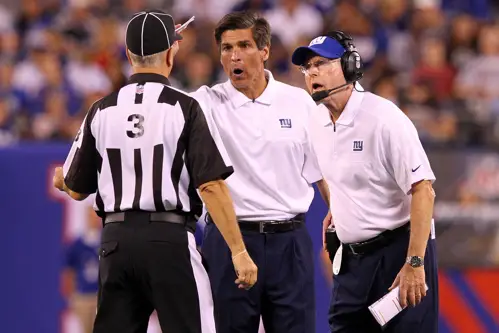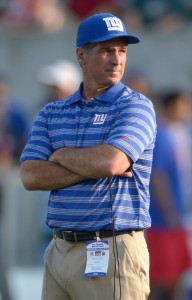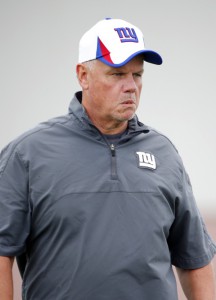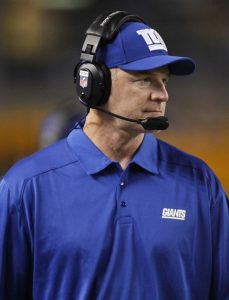[contentblock id=1 img=html.png]
For a team that has not fired its head coach since January 2004, there has been a tremendous amount of assistant coach turnover on the New York Giants the last two offseasons. In 2014, the team “retired” their offensive coordinator and fired their running backs and tight ends coaches. The quarterbacks coach was “demoted” to wide receivers coach and the wide receivers coach was “demoted” to tight ends coach. In 2015, the Giants fired their defensive coordinator and cornerbacks coach. The quarterbacks coach also left to pursue an opportunity in the collegiate ranks.
In short, the only coaching positions that have not changed in the last two offeasons are head coach, offensive line coach, defensive line coach, linebackers coach, safeties coach, and special teams coordinator. The amount of overall turnover in a two-year period has been remarkable.
Regardless if these coaches are old or new, all are now vulnerable on a team that has missed the playoffs three straight seasons. If the Giants miss the playoffs in 2015, with a schedule that includes only three playoff teams from 2014, there is a good chance the entire staff will be terminated. But let’s assume the Giants show enough progress to improve their overall record to 9-7 but miss the playoffs for a fourth season? Might John Mara and Jerry Reese retain Tom Coughlin and most of the staff for one more chance in 2016? It’s possible. And it’s also possible that they will only do so if other assistant coaches are let go.
In my opinion, there are three coaches on this team who are vulnerable to being released if their respective units do not improve. Each of these units have been very inconsistent in recent years, but the organization has dedicated a tremendous amount of personnel resources into improving the units. Now the pressure is on the coaches to turn these assets into improved results.
If you believe there is no way the entire coaching staff is retained if the team does not make the playoffs, then the work of these three coaches could prove decisive in the team’s overall success.
Special Teams Coordinator Tom Quinn
Tom Quinn has been the special teams coach of the New York Giants since 2007. Quinn probably gets more grief than he deserves from fans as his special teams did play an integral role in two NFL Championship runs in 2007 and 2011. In many of the playoff games, special teams were a critical factor in the victories. His units have also performed reasonably well in certain areas when given the tools. That said, special teams has far too often been the Achilles’ heel of the New York Giants.
In the last five seasons, the Giants have finished the regular-season 31st, 20th, 6th, 27th, and 17th in kick return average with only one kick return resulting in a touchdown. They have also finished 31st, 29th, 30th, 26th, and 19th in punt return average with no punt return touchdowns during that five-year span. David Wilson’s tremendous success as a kick returner in 2012 was the lone bright spot in the return game despite the fact the team has drafted prospects and signed free agents who were supposedly good return men. As the stats show, the Giants’ punt return game in particular has been anemic for a long time.
In terms of covering kickoffs, the Giants have finished 4th, 11th, 16th, 9th, and 2nd in the NFL with no kick return touchdowns allowed. In covering punts, the team finished 31st, 17th, 15th, 30th, and 27th with six punt return touchdowns allowed. In other words, kickoff coverage has been satisfactory but punt coverage has been dreadful and very costly at times.
During the last five years, the Giants have blocked two punts and have had two punts blocked. The kicking/punting game with Lawrence Tynes/Josh Brown and Steve Weatherford has been solid.
When taken as a whole, the special teams have been below average. Among fans, Quinn is the least popular coach on the team.
The team has dedicated a number of assets to Quinn this offseason, highlighted by Dwayne Harris, arguably the best all-around special teams player in the game. Harris not only returns punts and kicks, he also excels at covering punts and kicks. Harris was 2nd, 3rd, and 9th in the NFL in punt returns the last three seasons, with two scores. He was also also 2nd and 13th in the NFL in kickoff returns the last two seasons. Harris has been named “NFC Special Teams Player of the Week” three times. He was given an unprecedented 5-year, $17.5 million contract for a special teams player.
But the reinforcements don’t end with Harris. The Giants also signed special teams standout linebackers J.T. Thomas (3 years, $10 million) and Jonathan Casillas (3 years, $8 million) as well as re-signing linebacker Mark Herzlich (2 years, $2.6 million). Draft pick safeties Landon Collins and Mykkele Thompson excelled on special teams in college. The Giants project another draft pick, wideout Geremy Davis, as another special teams asset. And defensive ends Damontre Moore and Owamagbe Odighizuwa; linebacker Devon Kennard; cornerbacks Mike Harris and Chykie Brown; and safeties Nat Berhe, Cooper Taylor and Bennett Jackson should all be core special teamers.
Quinn should be out of excuses. He has a returner, kickers, blockers, and gunners.
Offensive Line Coach Pat Flaherty
Pat Flaherty has been the offensive line coach of the New York Giants ever since Tom Coughlin became the team’s head coach in 2004. Flaherty helped to construct one of the great offensive lines in team history: left tackle David Diehl, left guard Rich Seubert, center Shaun O’Hara, right guard Chris Snee, and right tackle Kareem McKenzie. This group peaked in 2008 when the Giants led the NFL in rushing. Since then, the line has had its moments but it has declined steadily despite a second NFL title in 2011.
The main problem is that the Giants have not done a good job of adequately replacing the five old foundation members – all of whom are now out of football. They got some solid play out of guard Kevin Boothe and center David Baas, but not much else (and both of those two players are now gone too).
The Giants have drafted a number of offensive linemen who have not performed well for the franchise, including Guy Whimper (4th round), Mitch Petrus (5th round), James Brewer (4th round), Brandon Mosley (4th round), Matt McCants (6th round), and Eric Herman (7th round). They also signed some veteran free agents last offseason who did not pan out: center J.D. Walton, guard John Jerry, and tackle Charles Brown.
Is the lack of development of these players the responsibility of Flaherty? Most likely not, but the team has spent resources to attempt to fix a sore spot that remains a sore spot. That does not help Flaherty’s case. The Giants were tied for 28th in the NFL last season in yards per rush. And while the Giants were 9th best in the NFL in sacks allowed with 30, that stat is misleading as Eli Manning was hit far too often in a West Coast offensive scheme based on a 3-step drop and a quarterback who historically does not take a lot of sacks.
The current Giants offensive line now has two first round draft picks (Ereck Flowers and Justin Pugh), two second round draft picks (Will Beatty and Weston Richburg), and one very expensive free agent acquisition (Geoff Schwartz, 4 years, $16.8 million). The expectation is that not only should the line no longer be one of the worst in the NFL, but it should develop into one of the league’s best. The pressure is on Flaherty for these pricey investments to perform.
Defensive Line Coach Robert Nunn
Robert Nunn has been the defensive line coach of the New York Giants since 2010 when Mike Waufle was fired. His lines have risen and fallen depending on the inconsistent performances of ends Jason Pierre-Paul, Justin Tuck, Osi Umenyiora, and Mathias Kiwanuka, and steadier performances from tackles Barry Cofield, Linval Joseph, and Chris Canty. In 2014, New York’s run defense was dreadful…dead last in the NFL in terms of yards per rush allowed.
Like Flaherty, a strong argument can be made that the coach has not had much to work with as the key older players have left the team. Gone are Michael Strahan, Tuck, Umenyiora, Kiwanuka, Canty, Cofield, and Joseph. The Giants have not adequately replaced these parts. But in the last two offseasons, significant assets have once again been focused on the line. The team has placed the franchise tag ($14.8 million) on Pierre-Paul. It has spent high draft picks on tackles Johnathan Hankins (2nd round) and Jay Bromley (3rd round) and ends Damontre Moore (3rd round) and Owamagbe Odighizuwa (3rd round). Free agent ends Robert Ayers and George Selvie and tackle Kenrick Ellis have been signed. The expectation is that once again the defensive line will become the foundation of Steve Spagnuolo’s defense. The pressure is on for this unit to perform at a high level.
It should be no revelation that two of the coaches in the hot seat are the line coaches. For the decline of the fortunes of the New York Giants since 2011 can be directly traced to the demise of the offensive and defensive lines. The Giants have been getting out-played up front. They have had problems running the football and defending the run. Pass rush and pass protection have been far too inconsistent. The franchise has dedicated a lot of resources to fix these problems. The outcome of the 2015 season will depend on how the lines perform.
Despite some playoff heroics, special teams has been a sore spot for years. Yet somehow Tom Quinn has avoided the executioner. The excuses to retain his services are running out. Ironically, Tom Coughlin’s fate may rest with Quinn. One or two games each year are won or lost because of special teams. Those one or two games could mean the difference between a playoff run or sitting home for the fourth time in a row in January.





